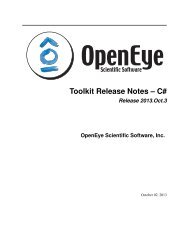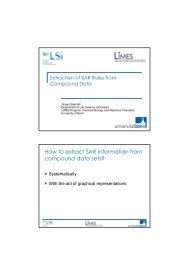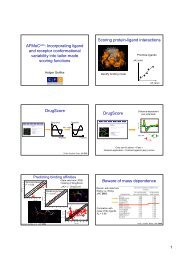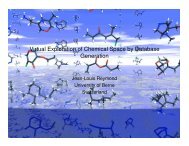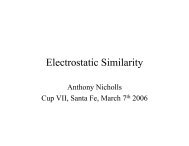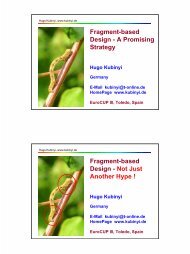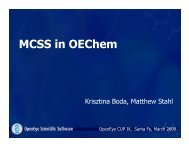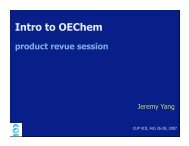OMEGA Release 2.5.1.4 OpenEye Scientific Software, Inc.
OMEGA Release 2.5.1.4 OpenEye Scientific Software, Inc.
OMEGA Release 2.5.1.4 OpenEye Scientific Software, Inc.
You also want an ePaper? Increase the reach of your titles
YUMPU automatically turns print PDFs into web optimized ePapers that Google loves.
• The XLogP parameter in the Filter Files chapter.<br />
11.4 LogS<br />
<strong>OMEGA</strong>, <strong>Release</strong> <strong>2.5.1.4</strong><br />
The work of [Yalkowsky-1980] at Arizona has resulted in what is now called the “generalized solvation equation.” It<br />
states that the solubility of a compound can be broken into two steps, first the melting for the pure solid to pure liquid<br />
and second, the phase transfer from pure liquid into water. For many small organic molecules, this second step is<br />
somewhat related to LogP.<br />
Because of this relation we choose to explore the use of the XLogP atom-types in solubility prediction. The expectation<br />
was that this might provide an approximate though robust and fast method for calculating solubility. We fit the XLogP<br />
atom-types to a training set of nearly 1000 public solubilities. From this we derived a linear model for solubility.<br />
The model is extremely fast and is useful for classifying compounds as insoluble, poorly soluble, slightly soluble,<br />
moderately, soluble or very soluble. The model is notable for the difficulty it has predicting solubilities for compounds<br />
with ionizable groups. Further, it is not suitable for the PK predictions that come late in a project. However, it is useful<br />
for eliminating compounds with severe solubility problems early in the virtual-screening process.<br />
See Also:<br />
The solubility parameter in the Filter Files chapter.<br />
11.5 Polar Surface Area<br />
Topological polar-surface area (TPSA) is based on the algorithm developed by Ertl et al [Ertl-2000]. In Ertl’s publication,<br />
use of TPSA both with and without accounting for phosphorus and sulfur surface-area is reported. However,<br />
evidence shows that in most PK applications one is better off not counting the contributions of phosphorus and sulfur<br />
atoms toward the total TPSA for a molecule. This implementation of TPSA allows either inclusion or exclusion of<br />
phosphorus and sulfur surface area with the default being to not include it.<br />
See Also:<br />
<strong>Inc</strong>luding phosphorus and sulfur surface area:<br />
• The PSA_USE_SandP parameter in the filter file<br />
Warning: TPSA values are mildly sensitive to the protonation state of a molecule. If the pKaNorm parameter is<br />
false, the TPSA value is calculated using the input structure and if pKaNorm is true, the TPSA is calculated using<br />
the pKa normalized molecular structure.<br />
See Also:<br />
• The pKa normalization section of the Filter Preprocessing chapter.<br />
• function<br />
11.6 Lipinski and Hydrogen-bonds<br />
The work of Lipinski ([Lipinski-1997]) introduced the application of simple filter-like rules to roughly predict latestage<br />
PK properties, in particular oral bioavailability. Unfortunately, Lipinski’s “Rule-of-Five” has come into the<br />
common vernacular to such a large degree that some of the specific details are often lost in the commotion. There are<br />
two critical examples of this. First, Lipinski used “violation of 2 rules” to categorize compounds. In the subsequent<br />
analysis, a significant difference in the two populations of molecules was detected, however, little analysis of the<br />
importance of a single violation was done. However, many now consider a single violation to be bad and two violations<br />
11.4. LogS 45



